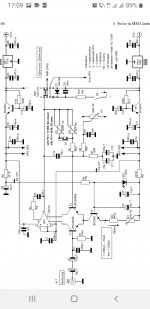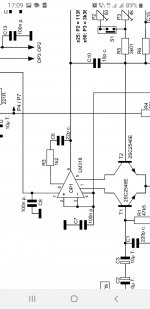As Mooly suggested, check if Zeners don't have cold solder joints that could be the cause of dead opamp. Then, as others suggest, replace 5534 by 5534 that is not from TI.
Maybe this is off topic, anyway
I have a Rotel preamp the RC-870BX it uses 5 5534, wich maybe is the best preamp in my collection
https://www.hifiengine.com/manual_library/rotel/rc-870bx.shtml
I asked some advice about upgrading the OP amps and I was told there is nothing better, I was thinking about the 2134
"Just leave the 5534. It's likely a low noise version and carefully selected by Rotel from batches of already low noise ICs"
Another idea what to changed it to the OPA-604 biased with a FET transistor into class A, like the Rotel tuner 990BX mods
Any advice ?
I have a Rotel preamp the RC-870BX it uses 5 5534, wich maybe is the best preamp in my collection
https://www.hifiengine.com/manual_library/rotel/rc-870bx.shtml
I asked some advice about upgrading the OP amps and I was told there is nothing better, I was thinking about the 2134
"Just leave the 5534. It's likely a low noise version and carefully selected by Rotel from batches of already low noise ICs"
Another idea what to changed it to the OPA-604 biased with a FET transistor into class A, like the Rotel tuner 990BX mods
Any advice ?
JRC are said to be better than others.
May be postage is more than the cost, it is a cheap item.
TL071 works, needs change in in / out resistors.
What is your problem, why do you want to change them?
May be postage is more than the cost, it is a cheap item.
TL071 works, needs change in in / out resistors.
What is your problem, why do you want to change them?
JRC are said to be better than others.
May be postage is more than the cost, it is a cheap item.
TL071 works, needs change in in / out resistors.
What is your problem, why do you want to change them?
Looking for improvements that all, I think is a super preamp want it to be better
Find another itch to scratc
Slew rates above 15 are usless in audio.
Op Amp rolling is a foolish trend, better make a new op Amp, try to excel some good circuit designers...
Slew rates above 15 are usless in audio.
Op Amp rolling is a foolish trend, better make a new op Amp, try to excel some good circuit designers...
I guess the 49990 is longer in production
I have a preamp with all 2134 so I am looking for a different opamp that the 2134
I have a preamp with all 2134 so I am looking for a different opamp that the 2134
I would have said that IC401 would better be ad797 only if you're using mc carts, but even in that case there's a bit of a problem in most phono preamps.The supply voltage is +-18V which coincides with the max supply of most of today op-amps while ne5532 can take +-22v...Leave it as it is!
Did you check the schematic for the preamp ?I would have said that IC401 would better be ad797 only if you're using mc carts, but even in that case there's a bit of a problem in most phono preamps.The supply voltage is +-18V which coincides with the max supply of most of today op-amps while ne5532 can take +-22v...Leave it as it is!
What do you think of it ?
As @naresh said already njm5534 are a little bit better than the originals in the common mode distortion department, but serious improvements ...only if you replace the input transistors of ne5534 like siliconix did with j-fet trz or others did in some applications with bipolar ttz.Lm194...394 would be your best bet .
You could try making a separate stage with ad797 for mc carts.All interventions would be difficult if you don't really know all the theory involved.
You could try making a separate stage with ad797 for mc carts.All interventions would be difficult if you don't really know all the theory involved.
Attachments
some friends are satisfy after use this OP-Amps from Analog devices as replacement for single version NE5534 and dual version NE5532:
1) AD825 (LC Audio like this type)
http://www.octave-electronics.com/lcaudio/ad825.shtml
2) AD817 (Graham Slee like this OP-Amp)
Both types offer internal schematic. Inside are only one voltage gain stage (folded cascode)+buffer stage, i. e. no separate differential input and no independent second stage as VAS.
The NE5534/5532 and TL071 variants operates with two gain stages (input differential amp and VAS stage include Cdom - obviously a disadvantage for the perception sound character despite the very good measuring results).
check also out this thread:
https://www.diyaudio.com/community/...st-possible-thd-n-really-the-best-way.367692/
Interesting to know for me is, whether the last TI generation of OPA16xxx outperform the AD825 and AD817 at a listening test. The LME series from National Semiconductor are not able to do this.
P.S.: Mike Moffat (Schiit Mani) like the ADA4897 and AD8066 - maybe also interesting alternatives for replace the NE's
https://www.stereophile.com/content/gramophone-dreams-6
also discrete versions - go to
https://www.diyaudio.com/community/...able-discrete-op-amps-overview-wanted.263440/
1) AD825 (LC Audio like this type)
http://www.octave-electronics.com/lcaudio/ad825.shtml
2) AD817 (Graham Slee like this OP-Amp)
Both types offer internal schematic. Inside are only one voltage gain stage (folded cascode)+buffer stage, i. e. no separate differential input and no independent second stage as VAS.
The NE5534/5532 and TL071 variants operates with two gain stages (input differential amp and VAS stage include Cdom - obviously a disadvantage for the perception sound character despite the very good measuring results).
check also out this thread:
https://www.diyaudio.com/community/...st-possible-thd-n-really-the-best-way.367692/
Interesting to know for me is, whether the last TI generation of OPA16xxx outperform the AD825 and AD817 at a listening test. The LME series from National Semiconductor are not able to do this.
P.S.: Mike Moffat (Schiit Mani) like the ADA4897 and AD8066 - maybe also interesting alternatives for replace the NE's
https://www.stereophile.com/content/gramophone-dreams-6
also discrete versions - go to
https://www.diyaudio.com/community/...able-discrete-op-amps-overview-wanted.263440/
Last edited:
Unscientifically, using AD825s in my Ben Duncan active crossover sounded better than the original NE5534s.some friends are satisfy after use this OP-Amps from Analog devices as replacement for single version NE5534 and dual version NE5532:
1) AD825 (LC Audio like this type)
http://www.octave-electronics.com/lcaudio/ad825.shtml
Ad825/817 max supply voltage =+-18V
Ada4897 max supply voltage 11V
Ad8066 max supply voltage =26.5v
This Rotel preamp has a supply voltage equal to +-18v
IC401 AND IC402 have two 30 ohms series resistors on the supply rails for the first stage.If you manage to increase those resistors accordingly so that the op amp idle current can drop the supply voltage such as the output of the first stage of the phono preamp doesn't enter clipping you might have a chance to hear how a modern op amp behaves on dusty records 🙂
That's if you get there in the first place cause you need to deal with their slew rates first:
https://www.audiosciencereview.com/...ra-gold-how-not-to-design-a-phonostage.34232/
I wonder how much more nonesense needs to be spilled over the swaping op amps ideology.
Ada4897 max supply voltage 11V
Ad8066 max supply voltage =26.5v
This Rotel preamp has a supply voltage equal to +-18v
IC401 AND IC402 have two 30 ohms series resistors on the supply rails for the first stage.If you manage to increase those resistors accordingly so that the op amp idle current can drop the supply voltage such as the output of the first stage of the phono preamp doesn't enter clipping you might have a chance to hear how a modern op amp behaves on dusty records 🙂
That's if you get there in the first place cause you need to deal with their slew rates first:
https://www.audiosciencereview.com/...ra-gold-how-not-to-design-a-phonostage.34232/
I wonder how much more nonesense needs to be spilled over the swaping op amps ideology.
Last edited:
That was not my experience. Some years ago I put together a jig to test CMR vs freq and the NJM's CM performance was deeper at low freqs but not flat vs freq like the Signetics and Raytheons 5534's were. Analog Systems sold an MA-332 which was a Raytheon 5534 selected for, among other things, linear and deep CMR. The LM4562 and OP1642 are both very good in this respect, and quite consistent across different production runs.As @naresh said already njm5534 are a little bit better than the originals in the common mode distortion department,
What in /out resistor changes are needed? As an amateur I'm a fan of the TL071. Cheap, FET input. good sound and unity gain stable from what I can tell, What caveats or downsides do you see in using this part? Thanks!JRC are said to be better than others.
May be postage is more than the cost, it is a cheap item.
TL071 works, needs change in in / out resistors.
What is your problem, why do you want to change them?
Same thing...v supply max =+-18v.if the preamp is not supplied lower you risk using op amps at their max specified voltage...
Most well known op amps specified for phono stages can be supplied up to at least +-25v .Ne5532, opa1642 can do +-22v .None of those phono specd op amps are available today.
Most well known op amps specified for phono stages can be supplied up to at least +-25v .Ne5532, opa1642 can do +-22v .None of those phono specd op amps are available today.
Last edited:
I had copied a circuit from a Kenwood manual for a phono pre, and the op amp I chose was the TL072, as its slew rate was higher than the 4558 and 5532, the other two available locally.
I made one for a friend, no internet searching for exotics....he gets parts for his business from the USA, I could have done something really unusual, asked him to get from Mouser or whatever.
I had to reduce the in and out resistors to about 22E or so, from the 100E in and 3k3 out for the original circuit, which was for AN6556 / M5218P ....
Then it worked okay, the volume was very low in the original set up.
Power supply is a 500 mA / 12V linear wall wart, it runs about 17 to the pre, enough, it is lightly loaded so voltage goes higher than rated...
That is also a factor, the output swing is better as you go up in supply voltage.
And earthing from TT to amp!
I made one for a friend, no internet searching for exotics....he gets parts for his business from the USA, I could have done something really unusual, asked him to get from Mouser or whatever.
I had to reduce the in and out resistors to about 22E or so, from the 100E in and 3k3 out for the original circuit, which was for AN6556 / M5218P ....
Then it worked okay, the volume was very low in the original set up.
Power supply is a 500 mA / 12V linear wall wart, it runs about 17 to the pre, enough, it is lightly loaded so voltage goes higher than rated...
That is also a factor, the output swing is better as you go up in supply voltage.
And earthing from TT to amp!
Last edited:
- Home
- Amplifiers
- Solid State
- NE5534N best quality replacement?

